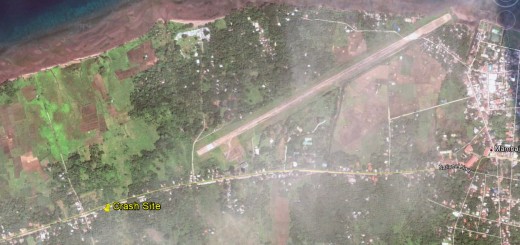Rock-Fall because of Camiguin Concrete Madness

Rock Fall near Tuasan Falls in Camiguin. Last night I got a message from a friend. He sent me a short movie clip taken last Saturday – April 23, 2016. The title of the message was: Prophet!
You may remember my articles “Concrete Madness in Camiguin” from May 12, last year or “Camiguin is loosing virginity” from April 20, this year. Just a week ago. Especially in the first article I described the danger of the slope near Tuasan Falls. I then wrote:
This hill will continue sliding and will only stop when the whole hill is down!
Any junior geologist knows that most volcanoes aren’t built of solid rocks. Mount Hibok-Hibok is a stratovolcano built of Hornblende andesite and dacite.
… and now the hill came down again!
Rock-Fall Warning
Do not drive up to Tuasan Falls. Heavy Rock-Fall may occur at any time!
Video courtesy of Jhunry Omaguing Clima. Thanks to Martin Geuther for transmitting.
Mount Hibok-Hibok is a stratovolcano
A stratovolcano, also known as a composite volcano, is a conical volcano built up by many layers (strata) of hardened lava, tephra, pumice, and volcanic ash. Unlike shield volcanoes, stratovolcanoes are characterized by a steep profile and periodic explosive eruptions and effusive eruptions, although some have collapsed craters called calderas. The lava flowing from stratovolcanoes typically cools and hardens before spreading far due to high viscosity. The magma forming this lava is often felsic, having high-to-intermediate levels of silica (as in rhyolite, dacite, or andesite), with lesser amounts of less-viscous mafic magma. Extensive felsic lava flows are uncommon, but have travelled as far as 15 km (9.3 mi). Stratovolcanoes are sometimes called “composite volcanoes” because of their composite layered structure built up from sequential outpourings of eruptive materials. They are among the most common types of volcanoes, in contrast to the less common shield volcanoes. (from Wikipedia)
There is no compact or grown rock. These hills are built of loose layers of rocks, pebbles, sand and ashes. Only vegetation, particularly trees, can stabilize such hills and mountains with deep reaching roots. Grass and scrubs hold back heavy rain. All thes plants have been removed to build a 4 lane highway.
The worst is to come
Above massive Rock-Fall happened after more than 8 weeks of drought. Camiguin is deeply dry. What will happen when the first heavy rains come? The well known tropical rainfalls will first wash out the fine ashes and sand. This will remove the temporary hold of pebbles and rocks. The rocks will fall! One doesn’t need to be a prophet to see this disaster come.
These landslides and rock-fall won’t stop until the whole hill will be down and the road gone! It is almost impossible to stabilize volcanic hills with engineered rock anchors. On Mount Vesuvius in Italy, the walking path to the crater has to be repaired after each strong rainfall.
There will be a disaster! The road is condemned to death. But there is even a worse scenario. If rainfall will last for several weeks, the whole hill will become a soapy, creamy mass. This mass will slide. Then it will create a barrage or dam and hold back the waters of Tuasan river. Once the pressure is high enough, the barrage will crack and the whole barangay of Mainit will be destroyed by an avalanche of rocks, pebbles and sand.
Is there a solution?
Sorry, I am known to be an optimist, but here all hope is lost. The only constructive solution would cost billions of pesos. The possible solution would consist of two gigantesque construction: The first one is an avalanche gallery like in the alps. This gallery is a kind of “on the surface tunnel” that protects the road from any falling rock. The second construction is a dam further down the river. This dam would hold back the rock and mud avalanches menacing Mainit.
Last warning
Do not go up to Tuasan Falls. If you are an addict of strong sensation, you may go up to point where the road descends towards the parking. From there you see the slope and can count the number of falling rocks.
[GARD]










1 Response
[…] Rock fall result of Concrete madness […]